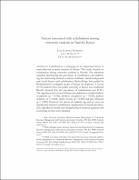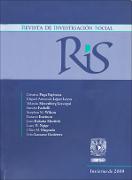Please use this identifier to cite or link to this item:
https://ru.iis.sociales.unam.mx/handle/IIS/5395| Title: | Factors associated with cohabitation among university students in Nairobi, Kenya |
| Authors: | Kabaria Muriithi, Joan Ngige, Lucy W. Mugenda, Olive M. |
| Keywords: | convivencia relaciones premaritales eleccion de la pareja matrimonio de lecho noviazgo union libre mate-selection come-we-stay marriages dating courtship cohabitation premarital relationships |
| Publisher: | Universidad Nacional Autónoma de México, Instituto de Investigaciones Sociales |
| Series/Report no.: | Revista de Investigación Social;Año VI, Número 9 |
| Issue Date: | 2009 |
| Abstract: | La convivencia se está convirtiendo en un factor importante para la elección de la pareja en muchas sociedades de Kenia. Este estudio se centró en la convivencia entre los estudiantes universitarios en Nairobi. Los objetivos fueron: determinar la prevalencia de la convivencia y establecer la relación entre las características de los estudiantes, los antecedentes familiares, los factores sociales y la convivencia. La metodología se basó en el modelo ecológico de desarrollo humano de Bronfenbrenner. Se llevó a cabo una encuesta con 176 estudiantes de una universidad pública de Kenia. Los resultados mostraron una prevalencia de convivencia de 27.4%. Los factores más importantes que conducen a la convivencia comprenden la profesión del padre (p = 0.016), la de la madre (p = 0.029), el lugar de residencia de los padres (p = 0.000), el ingreso familiar (p = 0.000) la influencia de los amigos (p = 0.000). Sin embargo, factores como la edad y el género de los estudiantes no se relacionaron de modo significativo con la convivencia. Se incluyeron las repercusiones por la educación familiar, la salud en materia de procreación y el fortalecimiento de la orientación a los estudiantes, así como los servicios de asesoramiento. Abstract: Cohabitation is emerging as an important factor in mate-selection in many societies in Kenya. This study focused on cohabitation among university students in Nairobi. The objectives included: determining the prevalence of cohabitation and establishing the relationship between students’ attributes, family background and social factors and cohabitation. Methodology was guided by Brofenbrenner’s ecological model of human development. A survey of 176 students from one public university in Kenya was conducted. Results showed that the prevalence of cohabitation was 27.4%. The significant factors that influenced cohabitation included fathers’ occupation (p = 0.016), mothers’ occupation (p = 0.029), parents’ residence (p = 0.000), family income (p = 0.000) and peer influence (p = 0.000). However, the factors of students’ age and sex were not significantly related to cohabitation. Implications for family life education, reproductive health and strengthening of students’ guidance and counseling services were included. |
| URI: | https://ru.iis.sociales.unam.mx/handle/IIS/5395 |
| Type: | PeerReviewed Artículo |
| Rights: | https://creativecommons.org/licenses/by-nc-sa/4.0 |
| metadata.dcterms.bibliographicCitation: | Kabaria Muriithi, Joan, Lucy W. Ngige y Olive M. Mugenda (2009). "Factors associated with cohabitation among university students in Nairobi, Kenya". Revista de Investigación Social 9 (invierno): 109-136. |
| Appears in Collections: | Revista de Investigación Social |
Files in This Item:
| File | Description | Size | Format | |
|---|---|---|---|---|
| 05_kabaria.pdf | Artículo | 177.93 kB | Adobe PDF |  View/Open |
| ris9_portada.jpg | Portada | 874.14 kB | JPEG |  View/Open |
Items in DSpace are protected by copyright, with all rights reserved, unless otherwise indicated.
